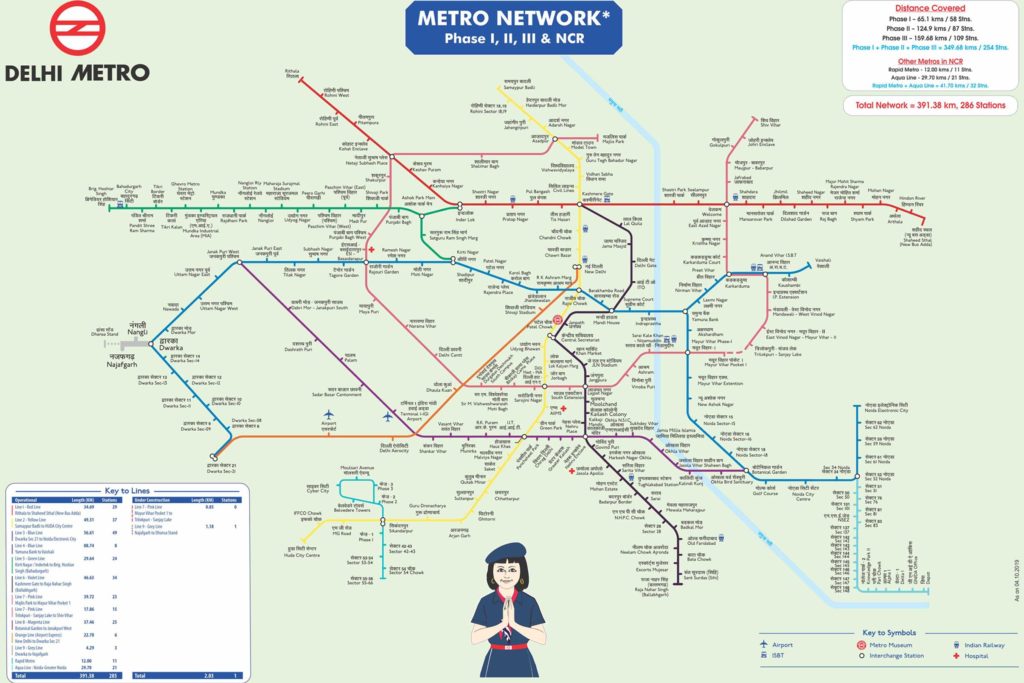Indoor Thrills and Chills – Pigeon Forge Activities for the Adrenaline Junkie
If you want to experience the thrill and adventure of...
After the Kolkata Metro, Delhi Metro is the second oldest in India and world’s 8th longest metro system. The network has colour-coded lines running approx. 347.66 kilometres with a mix of underground, at-grade and elevated stations. Delhi Metro operates more than 2700 trips on a regular basis, starting at around 5 in the morning and ending at 11 at night.

Those who visit Delhi for the first time and have not heard or seen the metro before may get confused or scared to travel by it. This is obvious as there are around 253 stations that the metro runs through and the colour-coded lines may leave them scratching their heads.
So before you step out to travel in the busiest and largest metro in India, first learn about the colour game going on in the Delhi Metro.
The entire game started in 2002 when the red line was made operational for the public. It stretches out to the North East and North West areas of Delhi and has 31 stations that run from ‘Rithala to New Bus Adda’, a total distance of 34.4kms. It interchanges with:
The third longest line of the Delhi Metro network, Yellow Line was made functional in 2004. It connects the north of Delhi to South i.e, from ‘Samaypur Badli’ to ‘Huda City Centre’ (37 stations) and covers a distance of approx. 48.8kms. It interchanges with
The longest line of Delhi Metro, Blue Line was opened in December 2005. It covers a distance of around 50.5kms and consists of 50 stations from ‘Dwarka Sector 21’ to ‘Noida Electronic City’. It interchanges with
It is the shortest metro line and was made operational in 2010. It covers 23 stations that stretch out to a distance of 29.6kms. Completely elevated, Green line was built as a part of the Phase-II of Delhi Metro. It runs mainly through the busy NH 10 route in West Delhi. It interchanges with
The Violet Line was introduced in October 2010 and it connects Central Delhi to South Delhi. This line covers a distance of 47 kms connecting ‘Kashmere Gate’ to ‘Raja Nahar Singh’. It interchanges with
It is the ‘Airport Express Line’ that was opened in 2011. Orange Line covers a distance of around 22.7kms, linking the ‘New Delhi Railway Station’ to ‘Dwarka Sector-21’. At ‘Dwarka Sector-21’ station, it terminates and joins the Blue Line.
It covers 25 metro stations starting from ‘Janakpuri West’ to ‘Botanical Garden’, and provides direct connectivity to Terminal 1D of Indira Gandhi International Airport. It interchanges with:
Also known as the ‘Ring Road line’, Pink Line consists of 38 metro stations from ‘Majlis Park’ to ‘Shiv Vihar’. However, some stations are under-construction and on completion, it will become the longest line of the Delhi Metro with a length of 58.59kms. It interchanges with:
The Grey line connects ‘Dwarka’ to ‘Dhansa Bus Stand’ located in Najafgarh; the total length of the line is 5.19kms. With only 3 stations, the Grey line has a single interchange at Dwarka station, connecting it to the Blue Line. it interchanges with:
The Aqua Line also known as ‘Noida Metro’ is a rapid transit system that connects Noida and Greater Noida to the rest of the Delhi Metro Network. There are a total of 21 metro stations starting from Noida Sector-51 and ending at ‘Depot Station’ in Greater Noida. It interchanges with:
In addition to the above lines, there is a ‘Rapid Metro Line’ that connects ‘Gurgaon’ to ‘Sikandarpur’ station of Yellow Line. There are 11 stations in total covering a distance of 12kms.
Foreigners visiting Delhi on their e-Visa India can alight at the following metro stations to visit most famous tourist places:
Note- Magenta Line provides direct connectivity to Terminal 1D of Indira Gandhi International Airport.
The best way to get into Delhi or to visit any other state from this city is by using the Indian Railways network. If you are traveling by train in India, Delhi Metro has provided connectivity to the major railway stations as well. Here is the list, have a look:
Delhi Metro is the ideal way to take a complete tour of the capital city. Factors like no stress of traffic jams, minimal waiting time, clean & hygienic, environmentally friendly, air-conditioned coaches and reasonable fares make Delhiites among the luckiest to have this transport facility.
So if you are planning to travel in Delhi by metro, save the information and take it along with you.